Annum Sabir is a newly qualified dentist, working as a DCT trainee in MaxFax.
Introduction
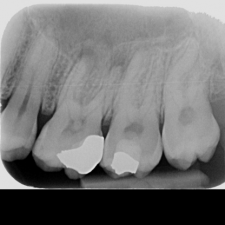
Pulp stones are concentrations of calcification in the dental pulp. Their cause is unknown, and no firm evidence exists that they are associated with any systemic or pulpal disturbance (White SC, 2000.)
As a foundation dentist, my knowledge on pulpal stones was very minimum. Quintessentially, all that was taught as a student was that if a pulp stone was present, the root canal treatment would be difficult and in some cases, impossible to carry out. However, now as a newly qualified dentist, when treating a tooth with a pulpal stone, not only did I learn how to manage this situation, I was intrigued to learn more around the subject and resolve these recurrent grey areas associated with pulp stones and endodontic treatment.
Case Report
A 20-year-old male with a symptomatic maxillary first left molar was assessed at a busy NHS practice. He complained of buccal tenderness, some discomfort on chewing and biting and slight sensitivity to hot and cold foods. The discomfort was sporadic and had occurred for a few days and he had visited an emergency dental clinic to which he was given a prescription of amoxicillin and advised to see a GDP.
On clinical examination, the maxillary first left molar showed slight gingival inflammation around the cervical margin and showed a very large distal amalgam filling extending very close to the pulpal tissue. The tooth was slightly tender to percussion and when vitality was tested using ethyl chloride, the tooth tested negative. The patient explained that he had finished his course of antibiotics and felt the tooth had significantly improved. There was still some tenderness around the gingivae but he stated this was only minimal.
.tmb-small.png?Culture=en-GB) Radiographic images followed which showed a large radiolucency on the apical aspect of all 3 roots. The canals looked patent but his radiograph also gives a slight indication there may be a pulpal stone present. In accordance to the American Association of Endodontics difficulty of this case was assessed as minimal risk.
Radiographic images followed which showed a large radiolucency on the apical aspect of all 3 roots. The canals looked patent but his radiograph also gives a slight indication there may be a pulpal stone present. In accordance to the American Association of Endodontics difficulty of this case was assessed as minimal risk.
A diagnosis of irreversible pulpitis following with periapical periodontitis. The following treatment options were given to the patient
-
Monitor the lesion within a given time frame to see if symptoms have lessened
-
Root canal treatment- explaining risks such as perforations, long appointment times, NaOCl incident, rubber dam, failure and success rates.
-
Extraction of tooth
Patient’s medical history was clear. He was a newly registered patient very motivated in saving his teeth. After discussion, it was decided to root treat the tooth and consent was obtained from the patient.
The tooth was anaesthetised with 2% lidocaine with 1:80000 and then isolated with rubber dam and clamp.
Access was achieved ensuring the full restoration wasn’t removed as this would then cause difficulty in isolation. Around diamond bur was used to locate the canal orfices, subsequently widened with gates glidden. The canals were irrigated with copious amounts of NaOCl (2.5%) throughout.
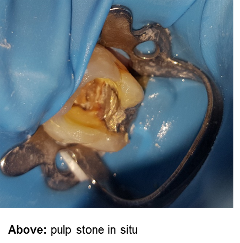 However, in removing the roof of the pulpal chamber, a pulpal stone presented which was causing difficulty in cleaning and shaping the canals.
However, in removing the roof of the pulpal chamber, a pulpal stone presented which was causing difficulty in cleaning and shaping the canals.
An intermediate dressing of non-setting calcium hydroxide was used in-between visits. On the following appointment, an ultrasonic scaler was used to slowly remove the stone to reveal full access to the pulpal chambers.
This was then controlled with plentiful irrigation to remove all debris and calcified tissue.
10% carbamide peroxide, 15% EDTA (Glyde) root canal condition was used in addition with irrigant to aid in cleaning the root canal system. 3 canals were located, the palatal, mesio-buccal and disto-buccal.
Initial cleaning and shaping of canals was approached by hand K files. This was followed by reciproc rotary system, which was used to shape canals at ISO size 25 at the tip with a taper of .08.
A working length radiograph was taken to assure canals were located followed by a dry run radiograph to confirm canals were cleaned to the apex. Measurements were taken and length were then adjusted.
The canals were irrigated, dried and Tubli-seal zinc oxide based coated a single gutta percha point before placing into the canals. The tooth was restored permanently with amalgam
Follow up appointment showed the tooth was not causing patient any sensitivity or pain. He noticed the tenderness had reduced even more so and was very happy with the result. Thus a successful endodontic case!
Discussion
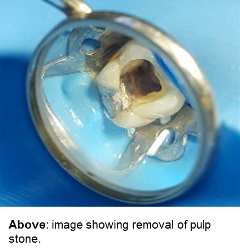 Pulp stones are foci of calcification in the dental pulp. (N Ozkalayci et al 2011).
Pulp stones are foci of calcification in the dental pulp. (N Ozkalayci et al 2011).
They range in size from small microscopic particles to large masses that almost obliterate the pulp chamber (Sisman, Y. et al, 2012).
Pulp stones can be diagnosed pre operatively from radiographs but can pose a threat when accessing teeth and cause difficulty in locating canals.
Pulp stones are usually found within the apical portion of the root can be differentiated by either being true pulp stones or false. True stones are comprised from dentine and lined with odontoblasts whereas the latterare formed from degenerating cells of the pulp that mineralize. Furthermore, the stones can also be classified as adherent with are attached to less dentine that embedded pulp stones (R Goga et al, 2008)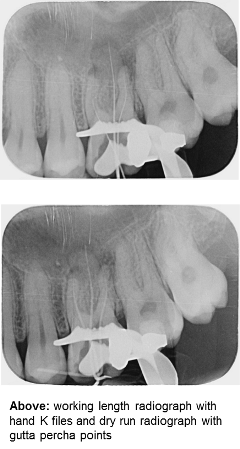 are formed from degenerating cells of the pulp that mineralize. Furthermore, the stones can also be classified as adherent with are attached to less dentine that embedded pulp stones (R Goga et al, 2008)
are formed from degenerating cells of the pulp that mineralize. Furthermore, the stones can also be classified as adherent with are attached to less dentine that embedded pulp stones (R Goga et al, 2008)
There is limited research to give an accurate understanding of the cause of pulp stones but there have been some implications such as tooth movement caused by orthodontics, age, gender, genetic predisposition caries, deep restorations and chronic inflammation (Sisman, Y. et al, 2012).
Radiographically, they appear as radiopaque structures in the pulp chambers or root canals of individual teeth. Generalized pulp stones throughout the dentition are usually associated with pulp4systemic or genetic disorders of the dentine (N Ozkalayci et al, 2011).
Jain,et al 2014, state that the location of root canal orifices can be difficult with the presence of pulp stones. Uncertainty of the normal anatomy of the pulpal system can be altered by the presence of a pulpal stone.
Furthermore, as mentioned by Pitt Ford 2002, Ultrasonic scaling special or sealer tips are invaluable in this situation as they are a minimally invasive option to allow the precise and accurate removal of dentine from the pulp floor without increasing the risk of perforation.
Conclusion
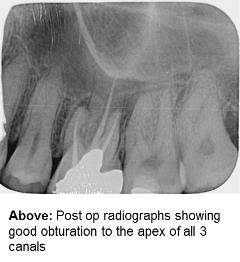
Pulpal stone can be problematic in the treatment of root canals. Radiographs provide a useful aid to detect early cases of pulp stones and so with correct understanding, risk assessing and correct technique, they can be carefully removed and thus enable efficient root canal treatment.
References
-
N Ozkalayci et al 2011 "Multiple Pulp Stones: A Case Report".Eur J Dent.Apr; 5(2): (2011): 210–214. Print.
-
Jain, Pradeep et al. "Successful Removal Of A 16 Mm Long Pulp Stone Using Ultrasonic Tips From Maxillary Left First Molar And Its Endodontic Management".Journal of Conservative Dentistry17.1 (2014): 92. Web.
- Pitt Ford, T. R, J. S Rhodes, and H. E Pitt Ford.Endodontics: Problem-Solving in Clinical Practice. London: Martin Dunitz, 2002. Print.
-
R.Goga et al
-
Sisman, Y. et al. "The Prevalence Of Pulp Stones In A Turkish Population. A Radiographic Survey".Med Oral(2012): e212-e217. Web.
-
The International Endodontic Journal, 41, 457–468, 2008
-
White SC, Pharoah MJ.Oral Radiology Principles and Interpretation.4th ed. St Louis: Mosby; 2000.)